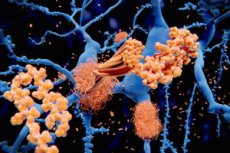
巴塞罗那自治大学 (UAB) 的研究人员已经确定了 α-突触核蛋白早期聚集体中的一个位点,可以通过定位该位点来防止其转变为在帕金森病患者大脑中积聚的有毒淀粉样蛋白原纤维。
该发现最近发表在《美国化学学会杂志》上,该研究加深了对这些初始聚集体或低聚物的结构特性的理解,并为开发新的治疗策略来灭活它们打开了大门。
这项研究由生物技术与生物医学研究所 (IBB) 和生物化学与分子生物学系的科学家 Salvador Ventura、Jaime Santos、Jordi Pujols 和 Irantzu Palhares 进行。
α-突触核蛋白聚集是帕金森病和其他突触核蛋白病的标志。这是一个动态过程,蛋白质自组装形成低聚物,最终发展成有毒的淀粉样蛋白原纤维,并在患者脑内积聚。
α-突触核蛋白寡聚体在疾病的发生发展中起着关键作用,因此有望成为治疗和诊断的靶点,尤其是在疾病的早期阶段。然而,其瞬时性和高度动态的特性限制了对其结构的研究,并使针对其的疗法的开发变得复杂。
在之前的研究中,研究人员发现,一种名为细菌肽PSMα3的小分子,通过与低聚物结合,阻止纤维化并抑制神经毒性,从而抑制α-突触核蛋白的聚集。在这项研究中,他们确定了这种结合在低聚物中发生的位置、方式和时间,从而确定了与帕金森病发病机制相关的结构转化过程的关键区域。
“我们鉴定出了将低聚物转化为原纤维所需的结构序列,从而为开发靶向低聚物的分子开辟了新领域。利用这一领域,我们可以设计出能够模拟PSMα3特性、亲和力和效力更高的新分子。”IBB蛋白质折叠和构象疾病研究组主任兼该研究协调员Ventura解释道。
结合结构、生物物理和生化分析,研究人员发现PSMα3通过结合α-突触核蛋白的一端(N端)发挥作用,而N端负责调节寡聚体转化为原纤维的过程。结合后,该肽覆盖了蛋白质的两个相邻小区域P1和P2,这两个区域已被证明对这种病理转变至关重要。
“这个区域是一个理想的治疗靶点,因为只有当肽是低聚物的一部分时它才会被肽识别,这使我们能够针对聚集体而不影响对正常大脑功能至关重要的 α-突触核蛋白的功能单体形式,”文图拉说。
这项研究还有助于更好地理解遗传性帕金森病的分子机制。这种疾病通常在较年轻时发病,通常与位于α-突触核蛋白P2区域的突变有关,例如G51D突变,这种突变会导致帕金森病最具侵袭性的形式之一。
研究人员发现,已确定的关键区域中的 G51D 突变会导致构象波动,从而减缓低聚物转化为纤维的速度。这种减缓导致有毒的长寿命低聚物的积累,而试图分解它们的分子伴侣无法有效地处理这些低聚物。
“我们的发现有望开发出针对这些突变型α-突触核蛋白的特定肽,从而为患有遗传性帕金森病的患者提供个性化的治疗方法。我们已经在开发这些分子了,”文图拉说。

